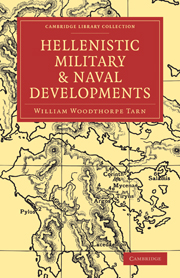Book contents
- Frontmatter
- PREFACE
- Contents
- Lecture I General Outline and Infantry
- Lecture II Cavalry and Elephants
- Lecture III Siege Warfare and Naval Warfare
- Appendix I The number of the Persian Cavalry
- Appendix II The Chinese evidence for the Great War-Horse
- Appendix III Surenas' Camels
- Appendix IV Δίκροτος in a recent papyrus
- Index
Lecture II - Cavalry and Elephants
Published online by Cambridge University Press: 05 October 2010
- Frontmatter
- PREFACE
- Contents
- Lecture I General Outline and Infantry
- Lecture II Cavalry and Elephants
- Lecture III Siege Warfare and Naval Warfare
- Appendix I The number of the Persian Cavalry
- Appendix II The Chinese evidence for the Great War-Horse
- Appendix III Surenas' Camels
- Appendix IV Δίκροτος in a recent papyrus
- Index
Summary
In the first lecture I considered the general features of Hellenistic warfare, and more especially the infantry; it is now necessary to consider the development of cavalry. The history of cavalry at this time belongs primarily to Asia, just as the history of infantry belongs to Europe; but the cavalry arm had been well developed in two Greek-speaking countries, Macedonia and Thessaly, and it was really the conjunction of Asiatic horse with Macedonian leadership which for a century after Alexander made cavalry the dominant arm. This was followed by a period in which such preponderance did not exist; then a new set of circumstances brought about a revival in Asia, and the period we are examining closes with a cavalry victory more extraordinary than anything Alexander ever dreamt of. Closely bound up with the history of cavalry is the history of the bow, a weapon whose fortunes were largely omitted from the first lecture.
When the Persians overran Western Asia they won their battles by a combination of cavalry and the bow; their archers threw the enemy into disorder, and then the cavalry charged and finished up what the archers had begun. It has recently been suggested that the spear, rather than the bow, was the national weapon of the Persians; but even if Darius I does speak metaphorically of the triumphs of the Persian spear, and pictures of Persian spearmen exist, I feel little doubt from the course of history that the traditional view is the correct one.
- Type
- Chapter
- Information
- Hellenistic Military and Naval Developments , pp. 50 - 100Publisher: Cambridge University PressPrint publication year: 2010First published in: 1930



